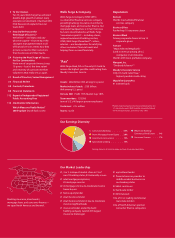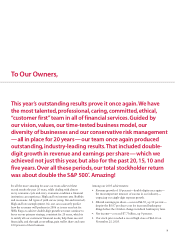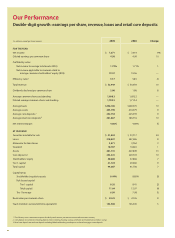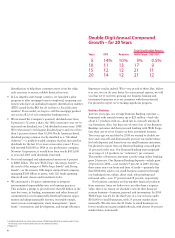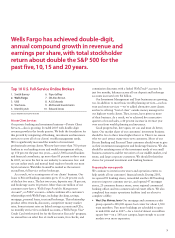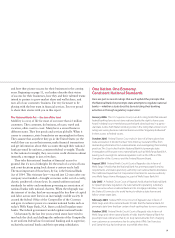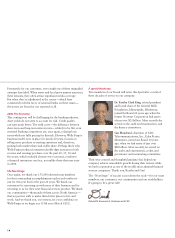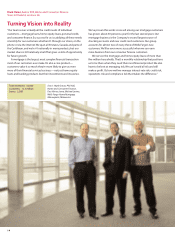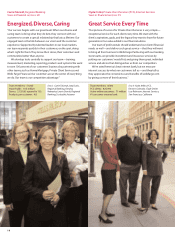Wells Fargo 2005 Annual Report Download - page 11
Download and view the complete annual report
Please find page 11 of the 2005 Wells Fargo annual report below. You can navigate through the pages in the report by either clicking on the pages listed below, or by using the keyword search tool below to find specific information within the annual report.
9
and how they picture success for their businesses in the coming
years. Beginning on page 11, our leaders describe their vision
of success for their businesses, how they and their talented teams
intend to partner to grow market share and wallet share, and
earn all of our customers’ business. I’m very fortunate to be
playing with the best team in financial services. I’m very proud
to share their stories with you in this report.
The National Bank Act—the law of the land
Mobility is a way of life for most of our more than 23 million
customers. They commute, do business, relocate, travel and
vacation, often coast to coast. Many have a second home in
different states. They buy goods and services globally. When it
comes to commerce, state boundaries are meaningless for them.
They assume that anywhere they go in the United States (or the
world) they can access their money, make financial transactions
and get information about their accounts through their national
bank governed by uniform, consistent federal oversight. Thanks
to this national oversight, they can receive credit decisions almost
instantly, a mortgage in just a few days.
They take this national freedom of financial access for
granted. But it’s not a birthright. It’s the result of a series of laws
and court decisions going back almost a century and a half.
The most important of those laws, by far, is the National Bank
Act of 1864. This visionary law—enacted just 12 years after our
company was founded—brought economic order out of a costly,
chaotic patchwork of state laws. It created uniform national
standards for safety and soundness governing an association of
national banks with national charters. When the telegraph was
the internet of its day, this law encouraged the free flow of capital
and labor across state lines in an increasingly mobile society. It
created the federal Office of the Comptroller of the Currency
and gave it exclusive powers to examine national banks such as
today’s Wells Fargo Bank, N.A. States could still regulate state
banks. The federal government would regulate national banks.
Unfortunately, the last few years several states have tried to
turn back the clock and challenge the authority of the Comptroller
to set uniform federal law for national banking and to supervise,
exclusively, national banks and their operating subsidiaries.
One Nation. One Economy.
Consistent National Standards.
Here are just six recent rulings that each upheld the principle that
the National Bank Act preempts state attempts to regulate national
banks—whether a state does this by restricting their banking
activities or through regulatory supervision:
January 2006 The U.S. Supreme Court, in an 8-0 ruling, holds that relevant
federal banking laws do not deny national banks the right to have cases
heard in federal court merely because the bank does business in a partic-
ular state.Justice Ruth Bader Ginsburg wrote in the ruling that a lower court
ruling was wrong because national banks would be “singularly disfavored”
in their access to federal courts.
October 2005 Federal District Court rules in favor of a financial services
trade association. It blocks the New York Attorney General’s Office from
demanding information from national banks and investigating their lending
practices.The Court rules that the National Bank Act preempts state
investigations of this type over a national bank such as Wells Fargo Bank, N.A.,
leaving such oversight to national regulators such as the Office of the
Comptroller of the Currency and the Federal Reserve Board.
August 2005 Federal Ninth Circuit Court of Appeals rules in favor of
Wells Fargo. It holds that the National Bank Act preempts state licensing
requirements and state supervisory authority over national bank subsidiaries.
The California Department of Corporations had tried to exercise authority
over Wells Fargo Home Mortgage,Inc., part of Wells Fargo Bank, N.A.
July 2005 A Federal Circuit Court of Appeals holds that the National Bank
Act preempts state regulation of a national bank’s operating subsidiary.
The case arose when a national bank and its mortgage subsidiary sued
the State of Connecticut to avoid having to obtain a state license and
follow certain state laws.
February 2003 Federal Fifth Circuit Court of Appeals rules in favor of
Wells Fargo and other national banks.It holds that the National Bank Act
preempts state laws that ban certain check-cashing fees to non-customers.
October 2002 Federal Ninth Circuit Court of Appeals rules in favor of
Wells Fargo and other national banks.It holds that the National Bank Act
preempts local ordinances that try to stop national banks from charging
non-customers a convenience fee for using their ATMs. San Francisco
and Santa Monica had ordinances to prohibit these fees.


